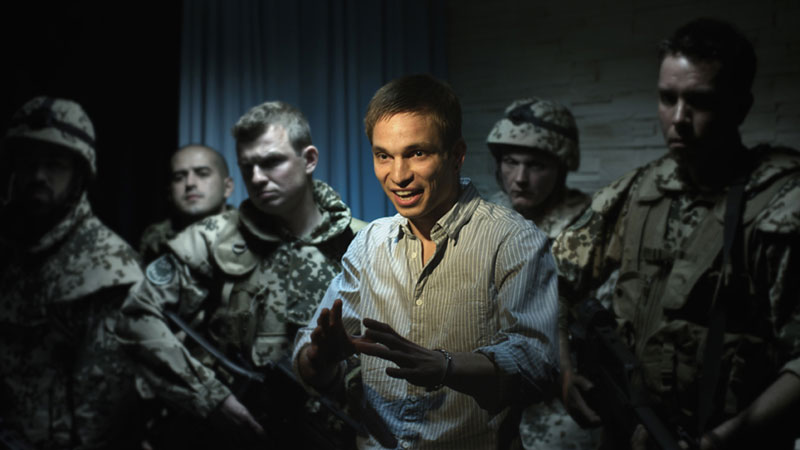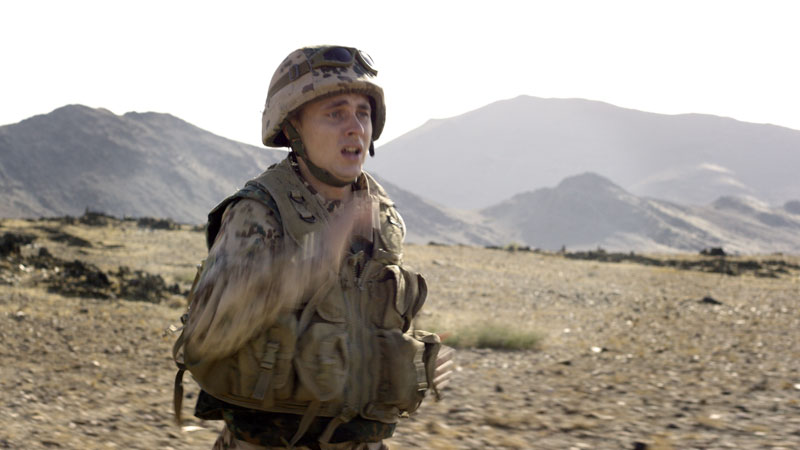Approaching the Omer Fast exhibition at BALTIC, the first words I hear are: ‘I love you. I miss you, even though we hardly spend any time away from each other.’ If this sounds like an unusually intimate welcome to a contemporary art show, then its source is less personal: a wall-mounted television at the exhibition’s entrance, the kind of screen that’s now a continuous presence in public spaces. It features a rapid video montage of television news clips, the headlines documenting terrorist threats and military responses. Having just left a hotel lobby where a similar screen endlessly repeated footage of a suicide bomb attack, I’m struck by the familiar images and mode of display. But the vulnerable words of this video offer emotional appeals and philosophical questions rather than the smooth tone normally adopted by television newsreaders. I start to feel sympathy for these anxious presenters: ‘Perhaps I talk too much? Maybe I come on a little strong?’
This is CNN Concatenated (2002), the earliest work by Fast in the BALTIC exhibition, and an ideal introduction to the themes and forms that characterise his practice. Born in Jerusalem in 1972, educated in America in the 1990s, and based in Berlin since 2001, Fast makes films that highlight how viewers are seduced and manipulated by narrative techniques. Made in the aftermath of 9/11, CNN Concatenated reminds us of the era’s paranoia around anthrax and airline security, and anticipates the narratives of warfare and terror that continue to dominate our screens and the artist’s work. Yet, as BALTIC’s brilliant survey confirms, Fast’s films move beyond media satire into more complex explorations of identity and authenticity.
It would be wrong, though, simply to trace a linear path through Fast’s career, starting with CNN Concatenated. For this is an artist determined to break with narrative conventions and traditional chronology. Take Continuity (2012) and Spring (2016), which explore the same, highly unstable fictional world. The former is a 40-minute film shown on a single large screen at BALTIC, in which we meet a bourgeois German couple. They pick up their son Daniel after his military service in Afghanistan and the family returns home to an excruciating dinner marked by traumatic flashbacks and incestuous interludes. The next morning the couple pick up another young man, played by a different actor, whom they also address as ‘Daniel’. The following day, the cycle repeats itself again, each time with a different version of the son and an alternative set of awkward conversations at the dinner table. Is there a ‘real’ Daniel? Or, perhaps, as Tom McCarthy suggests in the exhibition catalogue, the couple are simply hiring young men as part of an elaborate role play.
Continuity (2012; still), Omer Fast. Courtesy of gb agency, Paris, Arratia Beer, Berlin and Dvir Gallery, Tel Aviv; © Omer Fast

Spring, a 44-minute film commissioned for the BALTIC exhibition, acts as a prequel to Continuity. Shown across five connected but differently sized screens, as if to heighten a sense of fragmentation, Spring presents us with a teenage version of Daniel, who’s contemplating a military career while his parents’ marriage splinters. Other characters alluded to in Continuity are now fleshed out, notably a local baker who doubles as a drug dealer.
If the themes of Continuity and Spring are familiar – bourgeois sexual repression, small-town corruption, military trauma – then the narrative complexity with which Fast explores them is remarkable. What’s especially impressive is his ability to produce lengthy films that capture and hold a viewer’s attention no matter when one enters the screening space. These films loop, echo and repeat, without an obvious start or end point. As Fast explains: ‘To match the logic of the space and the unpredictable movement of viewers, I try to avoid linear storytelling. Instead, I structure my works so that they can be accessible at any time.’ The artist’s forthcoming feature film, an adaptation of Tom McCarthy’s 2005 novel Remainder, suggests that Fast is now prepared to confront the logic of the cinema space.
Given Fast’s manipulation of various media forms – from television news and documentaries to Hollywood thrillers – it’s perhaps inevitable that he’s interested in a filmic genre in which storytelling has an especially troublesome relationship with authenticity and intimacy: pornography. Everything That Rises Must Converge (2013) is a four-channel work detailing the daily lives of workers in California’s adult entertainment industry. Their banal routines – waking, commuting, cooking – bookend the shooting of a porn film which features the genre’s typically cursory approach to plot. Fast, however, shoots the central sex scene in an almost poetic fashion using close-ups, slow motion, and no sound. Does this imbue the action with more or less authenticity? Is ‘authenticity’ simply another stylistic device that a filmmaker can employ? And what happens if we give up on authenticity altogether?
‘Omer Fast: Present Continuous’ is at the BALTIC Centre for Contemporary Art, Gateshead, until 26 June.
Remainder opens in cinemas on 24 June.
From the May issue of Apollo: preview and subscribe here.



